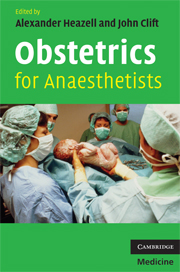Book contents
- Frontmatter
- Contents
- List of contributors
- Foreword
- Preface
- Acknowledgements
- List of abbreviations
- 1 Maternal physiology and obstetrics
- 2 Antenatal care
- 3 Induction of labour
- 4 Normal labour
- 5 Abnormal labour
- 6 Fetal monitoring
- 7 Pre-eclampsia and hypertensive disorders of pregnancy
- 8 Operative obstetrics
- 9 Obstetric haemorrhage
- 10 Thromboembolic disorders of pregnancy
- 11 Infection
- 12 Life support in obstetrics
- 13 Drugs in obstetrics
- 14 Confidential enquiries into fetal, neonatal and maternal death
- Appendix 1 Adult Advanced Life Support Algorithm
- Appendix 2 The Management of Postpartum Haemorrhage Algorithm
- Appendix 3 Emergency Management of Eclamptic Fit Algorithm
- Index
- References
9 - Obstetric haemorrhage
Published online by Cambridge University Press: 21 August 2009
- Frontmatter
- Contents
- List of contributors
- Foreword
- Preface
- Acknowledgements
- List of abbreviations
- 1 Maternal physiology and obstetrics
- 2 Antenatal care
- 3 Induction of labour
- 4 Normal labour
- 5 Abnormal labour
- 6 Fetal monitoring
- 7 Pre-eclampsia and hypertensive disorders of pregnancy
- 8 Operative obstetrics
- 9 Obstetric haemorrhage
- 10 Thromboembolic disorders of pregnancy
- 11 Infection
- 12 Life support in obstetrics
- 13 Drugs in obstetrics
- 14 Confidential enquiries into fetal, neonatal and maternal death
- Appendix 1 Adult Advanced Life Support Algorithm
- Appendix 2 The Management of Postpartum Haemorrhage Algorithm
- Appendix 3 Emergency Management of Eclamptic Fit Algorithm
- Index
- References
Summary
Introduction
Obstetric haemorrhage is classified with respect to the birth of the infant; antepartum haemorrhage (APH) describes any bleeding pv between the beginning of the 24th week of pregnancy and the delivery of the infant and postpartum haemorrhage (PPH) describes excessive blood loss following delivery. Obstetric haemorrhage may result in massive blood loss endangering the life of the mother, and the infant in the case of antepartum haemorrhage. In the Confidential Enquiry into Maternal and Child Health (CEMACH) 2000–2002, there were 17 maternal deaths directly attributed to haemorrhage. The CEMACH recommends that all obstetric units have a protocol for the management of obstetric haemorrhage; all individuals working in delivery units should be familiar with local guidelines.
Antepartum haemorrhage (APH)
Antepartum haemorrhage is defined as any vaginal bleeding after 24 weeks' gestation. It is a major cause of perinatal morbidity and mortality, including an increased risk of premature delivery. To a lesser extent APH increases maternal morbidity as a result of hospitalisation, operative intervention and coagulopathy. Rare causes of APH include cervical inflammation, cervical polyp, cervical cancer and vaginal trauma. Blood lost due to these causes is from maternal origin and is usually not significant. The four major causes of APH are:
Placental abruption
Placenta praevia
Uterine scar dehiscence
Vasa praevia
Placental abruption
Definition
Placental abruption describes premature separation of the placenta from the uterine wall; this may be partial or complete separation and can occur at any stage of pregnancy.
Keywords
- Type
- Chapter
- Information
- Obstetrics for Anaesthetists , pp. 107 - 119Publisher: Cambridge University PressPrint publication year: 2008



